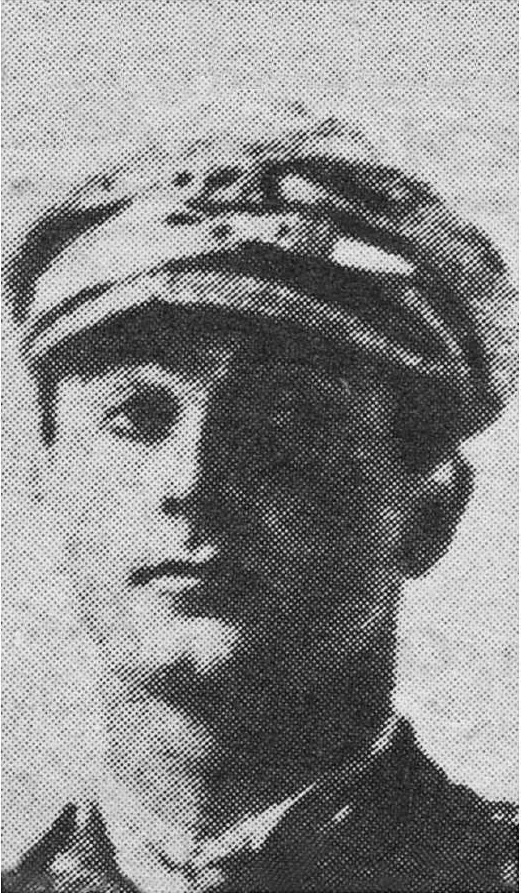Lt Col
Philip Eric Bent
Informations sur naissance
|
Date de naissance: 03/01/1891 |
|
Lieu de naissance: Halifax, Nova Scotia, Canada |
Informations générales
|
Profession: Second lieutenant , marine marchande |
Informations service militaire
|
Pays: Angleterre, Royaume-Uni |
|
Force armée: British Expeditionary Force |
|
Rang: Lieutenant Colonel |
|
Incorporation date: 02/10/1914 |
|
Unités: — Leicestershire Regiment, 9th Bn. (Dernière unité connue) |
Informations sur décès
|
Date de décès: 01/10/1917 |
|
Lieu de décès: Joist Farm, Zonnebeke, Belgique |
|
Cause du décès: Killed in action (K.I.A.) |
|
Âge: 26 |
Mémorial
|
Tyne Cot Memorial Panneau: 50A |
Distinctions et médailles 6
|
1914-15 Star Médaille |
|
British War Medal Médaille |
|
Distinguished Service Order (DSO) Médaille — 04/06/1917 |
|
Mentioned in Despatches Eervolle vermelding |
|
Victoria Cross Médaille — 11/01/1918 |
|
Victory Medal Médaille |
Points d'intérêt 2
| #1 | Lieu de naissance | ||
| #2 | Lieu du décès (approximatif) |
Mon histoire
Lieutenant Colonel Philip Bent served in the 9th Battalion Leicestershire Regiment, part of the 110th Brigade of the 21st Division. On 30th of September 1917 the Battalion marched up to Polygon Wood, which was captured by Australian Divisions a few days before. The Battalion took up positions on the right half of the Polygon Sector, just outside the wood where they dug in. In the morning of the 1st of October 1917. at 4.40 a.m., a German barrage came down on their positions. At 5.25 a.m., the Germans attacked, coming from Joist Farm and Cameron Covert, setting up a smoke screen. The first wave was stopped due to machine gun- and rifle fire from “A” Company. The second wave managed to penetrate the lines on the left flank. The situation looked threatening as “A” Company commenced to fall back. Lt.-Col. Bent, commanding “D” Company decided to organize a counterattack to recover their lost positions. He was killed in action while leading the counterattack between Polygon Wood and Joist Farm. Due to this counterattack, the German second wave attack came to a halt. His remains were never recovered due to the muddy condition of the ground and he is commemorated on the Tyne Cot Memorial to the Missing. He was posthumously awarded the Victoria Cross for this action. At 9.30 a.m. reinforcements arrived and were sent to the front line and the right flank. The Germans were heavily shelling Polygon Wood during the day and deployed airplanes to shell the front line. A corporal was able to take down an airplane with a Lewis machine gun. There was a lot of German activity and movement on the front, but after the barrage at 4 p.m. their movements stopped. The Battalion was relieved at 11 p.m. on the 5th of October 1917 by the 9th Battalion of the King’s Own Yorkshire Light Infantry and moved back to the camps.
Sources 5
|
9 Battalion Leicestershire Regiment , (The National Archives, KEW (TNA), WO 95/2165/2 ). https://discovery.nationalarchives.gov.uk/details/r/C14303 Autre référence |
|
Chapman P., In Memory and in Mourning - Tyne Cot Cemetery & Memorial, (Barnsley, Pen & Sword Books Limited, 2016), pg. 128. Sources utilisées |
|
McCarthy C., The Third Ypres Passchendaele. The Day-by-Day Account, (London, Arms & Armour Press, 1995), pg. 96. Sources utilisées |
|
Richardson M., The Tigers - 6th, 7th, 8th & 9th (Service) Battalions of the Leicestershire Regiment, (Barnsley, Pen & Sword Books Limited, 2000), pg. 196-200. Sources utilisées |
|
Snelling S., VC's of the First World War, Passchendaele 1917, (London, Wrens Park Publishing, 2000), pg. 163-166. Sources utilisées |
Complément d’informations 3
|
Lives of the First World War (Imperial War Museum) https://livesofthefirstworldwar.iwm.org.uk/lifestory/309919 |
|
Commonwealth War Graves Commission Database https://www.cwgc.org/find-records/find-war-dead/casualty-details/844778 |
|
Namenlijst (In Flanders Fields Museum) https://namenlijst.org/publicsearch/#/person/_id=cd574f8a-b4c3-4d5c-9ab0-eecece109ad1 |
